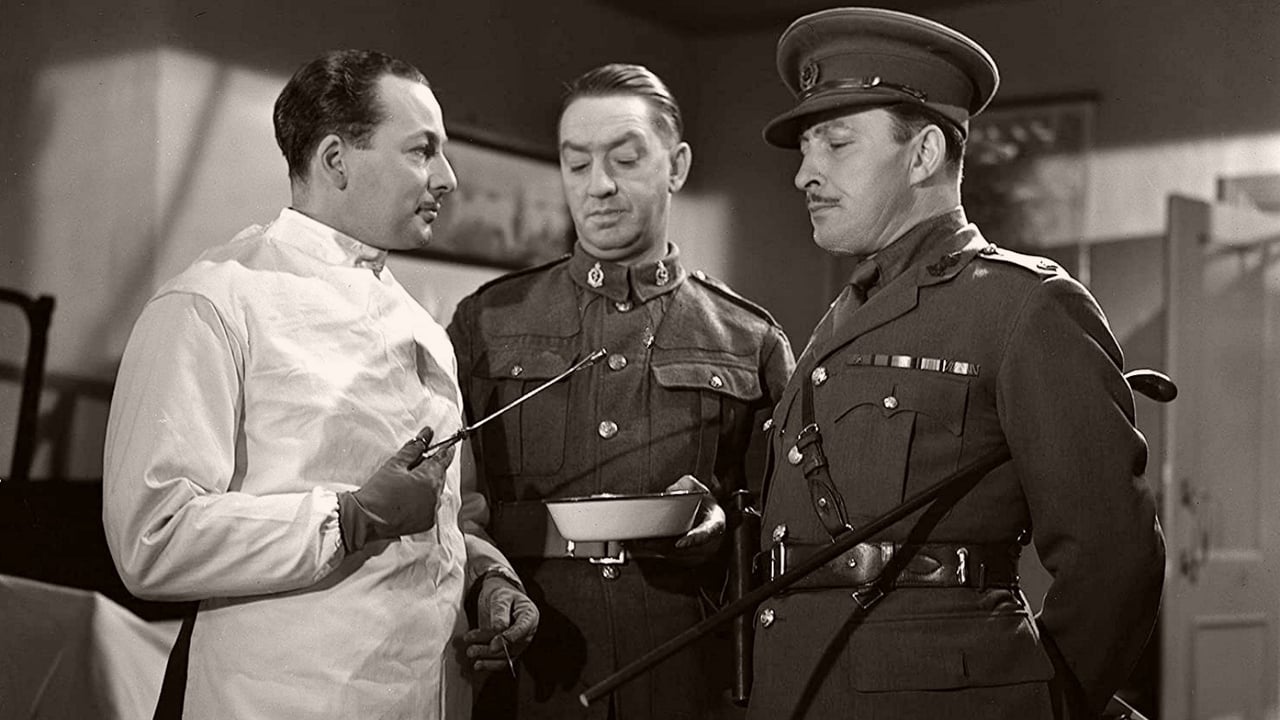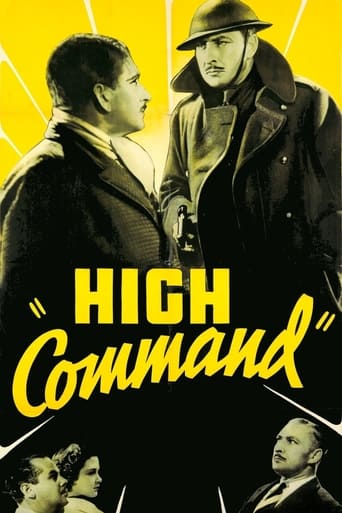

Lionel Atwill (Major-General Sir John Sangye), Lucie Mannheim (Diana Cloam), Steve Geray (Martin Cloam), James Mason (Heverell), Leslie Perrins (Carson), Allan Jeayes (governor), Michael Lambart (Lorne), Henry Hewitt (defence counsel), Wally Patch (Crawford), Kathleen Gibson (Belinda), Tom Gill (Daunt), Philip Strange (Major Challoner), and Frank Atkinson, Evan Thomas, Cyril Knowles.Director: THOROLD DICKINSON. Screenplay: Katherine Strueby. Dialogue: Walter Meade, Val Valentine. Based on the 1936 novel The General Goes Too Far by Lewis Robinson. Photography: Otto Heller. 2nd unit photography: Jack E. Rogers. Film editor: Sidney Cole. Music: Ernest Irving. Art director: R. Holmes Paul. Costumes designed by Arnulf Viberacker. Production manager: Cecil Dixon. Assistant to the producer: J. Sligo. Sound supervisor: Stephen Dalby. Sound recording: Paul F. Wiser. RCA Sound System. Producer: Gordon Wellesley. A Fanfare Production, made at A.T.P. studios, Ealing.Copyright 15 July 1938 by Grand National Films, Inc. No recorded New York opening. U.S. release: 15 July 1938. Released through Associated British Film Distributors in the U.K. in May 1937. 90 minutes. Re-issued in the U.K. by Renown Pictures in 1945 in a version cut to 74 minutes. U.S. length: 59 minutes.SYNOPSIS: Following an ambush in Ireland in 1921, Major Sir John Sangye, V.C., and a civilian, Challoner, find themselves the sole survivors. Challoner accuses Sangye of being the father of his wife's child and draws a revolver. Sangye, however, is too quick and kills him, but Carson, the medical officer, discovers Sangye's secret.Sixteen years later, Sangye, now a General, is in command of a West African Garrison to which Carson is attached. Sangye's step- daughter, Belinda is with him and Carson knows that she is really the General's own daughter. Carson makes a play for her. Heverell, Carson's cousin and brother officer, is having an affair with Diana, wife of Martin Cloam, a trader, but Cloam erroneously believes that Carson is Diana's lover.COMMENT: Court-martial drama very capably and stylishly directed by Thorold Dickinson — though we might except his failure to integrate the location material shot by photographer Jack E. Rogers with the studio material photographed by Otto Heller. Acting is solid — and the cast is certainly a very interesting one. The dialogue by Walter Meade and Val Valentine is at its best in the court-room exchanges (we love Atwill's line: "I shall decline to follow you into the realm of vague speculation." — "And the court must decline too, Mr Stebbins.") and holds interest throughout at an engrossing level.
... View MoreThe High Command has the advantage that American made films concerning Africa do not, that being actual location shooting in Africa because the UK was occupying large chunks of it. The story itself did not deal with the jungle per se, but rather is a tedious soap opera involving some of the occupiers.The story really begins back during the Irish Rebellion in 1921 where during a fit of rage Lionel Atwill murders a man who stole his sweetheart from him and married her. The blame is easily put on the Sinn Fein rebels, but a certain army doctor keeps the ballistic evidence of the crime.Fast forward fifteen years later to West Africa and Atwill and the doctor are stationed together again. The doctor is murdered, but the blame falls not on Atwill, but another man, James Mason who was thought to be embezzling company funds.The High Command is static and talky with everybody going around in the best stiff upper lip tradition. We certainly can't let these Africans know that their occupiers morals are less than perfect.Some good photography of Nigeria and the Gold Coast (later Ghana) is wasted on a trite story with characters you really cease caring about halfway through.
... View MoreThe High Command is a static and turgid mess that hints at great promise but never delivers the goods. Lionel Atwill stars as a British army officer who has a dirty secret: before being stationed in West Africa, he murdered a man in Ireland and blamed the death on the Irish Republican Army. Atwill is fine, but the rest of the cast is lacking--particularly a restrained James Mason, who looks uncomfortable underneath an assortment of false moustaches. Director Thorold Dickinson gives it the old college try, and his set-ups reflect the influence of Soviet social realism, the British documentary movement of the period, and even a hint of Hitchcock. Sadly, The High Command's talky story is completely uninvolving and Dickinson's visual flair is held in check as the film trudges to a mind-numbingly dull courtroom conclusion.
... View MoreBased upon a novel by Lewis Robinson, who assists with the script, HIGH COMMAND gives us a complex tale of blackmail, murder, and other delights, ranging over two continents and two generations, beginning in 1921 Ireland and concluding in West Africa (most of the film was shot in Nigeria and Gold Coast). General Sir John Sangye (Lionel Atwill), holder of the Victoria Cross and commander of a colonial garrison, in order to help protect his daughter Belinda (Kathleen Gibson) from unsavoury scandal, is forced into making several wrenching decisions, with Atwill giving the finest crafted performance of his career. In his first effort at directing a feature film, Thorold Dickinson displays the fluid work with a camera which marks his distinguished career, and has expertly taken a balance of drama and humour from the script while effectively leading his talented cast into strong performances, notably from Steven Geray, Leslie Perrins, James Mason and Lucie Mannheim. Dickinson, along with cinematographer Otto Heller, benefit from their background in silent cinema, and Ernest Irving's score is adroitly woven into the action, all of which assists in effectuating a masterwork.
... View More